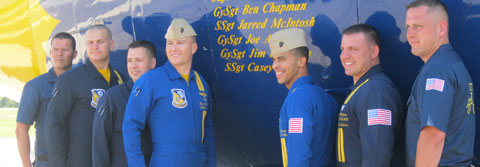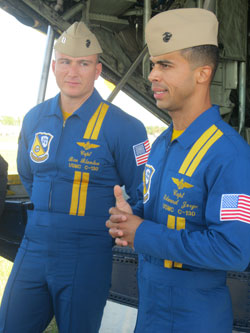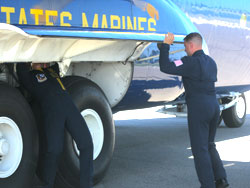‘Party time!’
F/A-18, C-130 flights spread aviation bug ‘in a huge way’

With four Rolls-Royce Allison turboprop engines generating more than 18,000 shaft horsepower, the Blue Angels Fat Albert Lockheed-Martin C-130 Hercules wrestles to stay planted on the runway until Capt. Ben Blanton and his crew release the brakes. The cargo aircraft, known for short-field takeoffs and landings, quickly accelerates to 125 mph. Blanton lifts off to fly five feet or less above the deck and pitches up 45 degrees to 1,200 feet after reaching 200 mph. ( Fat Albert no longer performs the famed jet-assisted takeoff.) With speed quickly bleeding down to 125 mph, Blanton pitches down, giving the crew in the cargo hold six seconds of weightlessness. The loadmaster and other crew members of Fat Albert Airlines are ready, using those fleeting seconds to levitate horizontally.
“You’re gonna feel like you’re on the space station for a second or two,” Blanton says in the passenger briefing before the flight.
The Blue Angels are performing a high impact, maximum demonstration of the C-130’s capabilities for thousands of spectators spread across a hillside at Virginia’s Lynchburg Regional/Preston Glenn Field May 22. Fat Albert, added as a Blue Angels demonstrator in 1970 and named after a cartoon, is a crowd pleaser, especially with children. It’s not as loud as the Blue Angels’ F/A-18 Hornet, and more importantly, it “has a yellow nose,” Capt. Eddie Jorge points out.
Blanton and Jorge fly 60-degree bank turns and demonstrate the tight turning radius of the aircraft. The rapid changes between 2 Gs and zero Gs, and a lack of visual reference to the ground, leaves at least one passenger feeling as if she’ll continue rolling over during entry into the steep turns.
The two also make high-speed, low-altitude passes down Runway 22 in front of the crowd.

“One of the ways that we would stay alive in a combat situation to avoid enemy detection is to get low, go fast, tuck into the terrain, so I’m going to demonstrate just how fast this airplane can go and how low it can go,” Blanton says. “I’m going to get about 60 feet off the deck … bring it up to 320 knots, about 370 mph.”
After a 10-minute flight of grunting, cheering, and rocking in a steamy, dark cargo hold, the passengers brace for landing as Loadmaster Staff Sgt. Casey Brey gestures and mouths “We’re going down!” The aircraft slows to 95 knots, just above stall speed, before pitching down 25 degrees (creating another few seconds of weightlessness) to reach 145 knots.
 Capt. Ben Blanton (left) and Capt. Eddie Jorge brief passengers on the C-130 maximum demonstration performance.
Capt. Ben Blanton (left) and Capt. Eddie Jorge brief passengers on the C-130 maximum demonstration performance.
“Some pilots like to pride themselves on just how smooth they can touch down. My intent is to pick a point on the runway, put the airplane down, and get it stopped,” Blanton explains. “As soon as I get on the ground, I’m going to go max reverse brakes and go ahead and stop this airplane.
“We’ve got about a 100,000-pound airplane today; we’re going to stop in about 1,000 feet. You’re gonna feel me get on those brakes.” Mission accomplished. The passengers could smell the brakes too.
While passengers on Fat Albert Airlines were briefed on the max-performance routine (although the rapid-fire crew brief was so fast that even a pilot had difficulty comprehending), troops on the ground who are being evacuated by C130s encounter a similar experience but in the cloak of darkness without the benefit of a briefing.
Aviation ambassadors
The Blue Angels, formed in 1946 and named after New York City’s Blue Angel nightclub, support recruiting efforts for the Navy and Marines. But they also instill the dream and wonder of flight in millions of spectators every year.
They impact the most people with the speed, power, and grace of the F/A-18s performing precise maneuvers as low as 50 feet and head-on passes with closure rates approaching 1,000 mph. Seemingly synchronized gasps and cheers erupt from spectators while “Born to be Wild” and the Top Gun theme song, among others, keep the audience on their feet for the duration of the demonstration.

But the Blue Angels also target key influencers in the airshow communities. Selected nominees ride in an F/A-18 or Fat Albert. Shannon Beasley, a science and technology teacher at the Central Virginia Governor’s School had an “out of this world” ride May 18 in an F/A-18 Hornet. The Blue Angels have used the F/A-18 for nearly 25 years, longer than any other jet.
Beasley was nominated for the flight by Retired Naval Rear Adm. Jones Stanley who is also a pilot. Now she’s hoping he’ll help her with another kind of flight. “I think I’d like to take lessons,” Beasley says, still beaming four days after the flight. “I really think I caught the bug in a huge way.”
Also during the airshow season, the flight surgeon visits terminally ill hospital patients, and four Blue Angels are selected to visit high schools each Friday near show sites.
Jorge, of Miami, Fla., still remembers when a Blue Angels pilot visited his high school 20 years ago. He had always wanted to be a pilot.
“You’ve always gotta have a plan,” says Jorge, who earned his Bachelor of Science in Aeronautics at Embry-Riddle Aeronautical University. Determination and setting goals are key to achieving those plans, he says, adding that pilots need to remember why they “chose this profession” when times get tough. Jorge’s dedication paid off. He’s serving his third and final year as a C-130 pilot for the Blue Angels and has 2,800 hours total time, including, 2,500 hours in C-130s and 300 combat hours. He was selected to the team with 2,300 flight hours.
Of his last year with the Blue Angels, Jorge says he’ll miss it, but quickly adds that he’s also “eager to go back out there.” Jorge served in Operation Iraqi Freedom and has flown missions in more than 25 locations around the world.
Safety first
The elite demonstration team comprises about 120 members, including the F/A-18 and C-130 pilots, mechanics, public affairs officers, flight surgeons, and support staff. All volunteer to be part of the group and serve two or three years, depending on the position. About 45 crew members travel to each show, with Fat Albert, their sole C-130, providing the heavy lifting—spare parts, crew supplies, etc.

As with any aviation endeavor, problems arise along the way. The team doesn’t hesitate to make a no-go or knock-it-off decision based on safety, even if it means canceling an appearance.
The Blue Angels jet demonstration team ended their routine early at Lynchburg May 22 because of a “lower-than-normal maneuver that took place.” The commanding officer issued a safety stand down, canceling a mid-week show, and had the group return to the Blue Angels headquarters in Pensacola, Fla., for additional training. The commanding officer later stepped down from the demonstration team. At any point during a routine, a crew member can call off the demonstration because of a safety issue.
 Fat Albert crew members inspect the brakes for safety.
Fat Albert crew members inspect the brakes for safety.
A media flight in Fat Albert scheduled for April 3 at Sun ‘n Fun in Lakeland, Fla., was canceled because a problem with the left brake could have created a safety hazard during the max braking demonstration. The crew nursed the aircraft back to Pensacola where the brakes could be repaired in advance of the next show date. The Hercules’ arrival in Lynchburg was delayed a few days because one engine needed to be replaced.
Training is also a top priority. Each year, the pilots train intensively in El Centro, Calif., January through March to perfect their routines. The pilots spend hundreds of hours practicing. Even Fat Albert’s nonpilot crew initially practices 10 times a day for 14 days to learn the performance, explains Brey, who has been with the Blue Angels since September 2010.
Throughout the airshow season, the F/A-18 pilots practice their routine eight to 10 hours each week. Daily practice and gym workouts allow them to fly without G suits. They anticipate the changes in Gs and tighten muscles as needed to prevent their blood from pooling.
Fat Albert’s crew practices its 10-minute demonstration 2.5 to 3 hours a week, Jorge says. That practice was evident on the May 22 Fat Albert flight, as passengers began taking cues to brace for sudden changes in bank or pitch based the crew’s movement in the cargo area. But the routine doesn’t become mundane; the crew loves their job. As the whir of the Rolls-Royce engines crescendo during engine startup for yet another performance, one crewmember exclaims, “All right, party time!”


